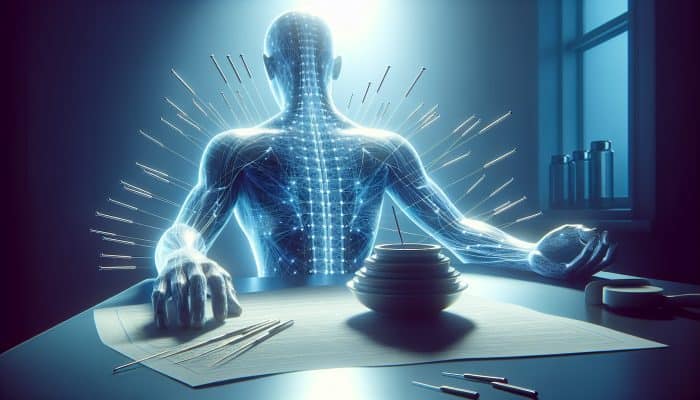Exploring the Significant Role of Acupuncture in the UK Healthcare System
Examining the Historical Development of Acupuncture Practices in the UK

Acupuncture has become a crucial aspect of the alternative medicine landscape in the UK, marked by a significant surge in both public acceptance and its integration into conventional healthcare frameworks. The historical evolution of acupuncture in the UK spans several decades, showcasing key milestones that have profoundly influenced its acceptance and application. Initially viewed as an exotic practice, acupuncture has now established itself as a credible therapeutic option, especially noted for its effectiveness in alleviating conditions like nerve pain. Key milestones include:
- 1970s: Acupuncture began gaining popularity through cultural exchanges with China, leading to the formation of the first acupuncture association in the UK.
- 1980s: An increase in public interest solidified acupuncture’s status as a complementary therapy, enhancing its visibility and applications.
- 1995: The British Acupuncture Council was established to promote safety standards and ethical practices in acupuncture.
- 2000s: A growing body of research published in UK medical journals validated the effectiveness of acupuncture for various medical issues.
- 2010: Acupuncture was recognized in the National Health Service (NHS) guidelines as a viable treatment for specific health concerns.
- 2020: The role of acupuncture in pain management was highlighted, particularly as many individuals sought alternatives to traditional pharmaceuticals during the post-pandemic recovery phase.
This historical overview underscores the remarkable transformation of acupuncture in the UK, enhancing its credibility among healthcare providers and patients alike who are seeking effective and reliable treatment options.
Understanding the Regulatory Landscape and Standards for Acupuncture in the UK
Regulatory bodies play an essential role in maintaining high standards of safety and efficacy across acupuncture practices in the UK. These organizations establish a professional framework that emphasizes patient safety and treatment quality. The key regulatory bodies include:
- The British Acupuncture Council (BAcC)
- The Acupuncture Association of Chartered Physiotherapists (AACP)
- The British Medical Acupuncture Society (BMAS)
- The Complementary and Natural Healthcare Council (CNHC)
These organizations are responsible for setting rigorous standards for training and clinical practice, while actively promoting the profession to ensure that acupuncturists possess the necessary qualifications and competencies to provide effective treatments, thus fostering trust and confidence among patients seeking care.
Enhancing Accessibility to Acupuncture Services Throughout the UK
Access to acupuncture services is steadily improving across the UK, providing a wide array of individuals with alternative treatment options for conditions such as nerve pain. The expanding network of practitioners ensures convenient access to care for patients. Various avenues for accessing acupuncture services include:
- Private acupuncture clinics established in both urban centers and rural regions.
- Some NHS facilities that have integrated acupuncture into their pain management programs.
- Community clinics that offer affordable acupuncture services to the public.
- Mobile acupuncture services designed to reach patients in more isolated areas.
This diverse range of access points affirms that acupuncture remains a feasible treatment option for many, highlighting its significance within the broader context of holistic healthcare.
Gaining Expert Insights on the Efficacy of Acupuncture for Nerve Pain Relief

Showcasing Successful Case Studies and Achievements in Acupuncture Treatments
Numerous practitioners across the UK have reported notable success stories involving acupuncture in the management of nerve pain. One illustrative case involved a 45-year-old woman experiencing sciatica, who found remarkable relief after undergoing a series of targeted acupuncture sessions. Her treatment consisted of precise needling along the sciatic nerve pathway, leading to significant pain alleviation and enhanced mobility. Another compelling example featured a middle-aged man suffering from diabetic neuropathy, who experienced reduced pain levels and improved sensation in his feet following consistent acupuncture treatments.
Practitioners often emphasize the personalized nature of treatments, adjusting their techniques to accommodate each patient’s unique nerve pain condition. Patient testimonials frequently highlight substantial reductions in discomfort and improvements in overall quality of life. By integrating acupuncture into their routine pain management strategies, patients have embraced a more holistic approach that minimizes reliance on pharmaceuticals while alleviating associated side effects.
Professional Recommendations for Developing Effective Acupuncture Treatment Plans
Acupuncture specialists in the UK advocate for a structured and methodical approach to addressing nerve pain through acupuncture. Initial consultations typically involve a comprehensive assessment of the patient’s medical history, alongside a detailed examination of their specific pain characteristics. Following this evaluation, practitioners can formulate a tailored treatment strategy that aligns with the individual’s needs. Experts suggest that patients take the following actionable steps:
- Identify and consult a qualified acupuncturist with specific expertise in treating nerve pain.
- Engage in a thorough discussion regarding the treatment plan, covering expected outcomes and timelines.
- Follow the recommended frequency for sessions, which usually ranges from once a week to bi-weekly, depending on individual progress.
- Monitor progress closely and maintain open communication with the practitioner regarding any changes in symptoms.
These recommendations underscore the importance of collaboration between patients and acupuncturists, ensuring that treatments are not only personalized but also effective in achieving the desired health outcomes.
Identifying Key Factors That Influence Acupuncture’s Effectiveness for Nerve Pain Relief

The effectiveness of acupuncture in managing nerve pain is largely attributed to its unique ability to stimulate the body’s inherent self-healing mechanisms. This practice focuses on specific points along meridians to enhance the flow of energy, also known as “Qi,” which effectively diminishes pain signals and inflammation in targeted areas. Recent research conducted in the UK has shed light on how acupuncture influences pain perception by promoting the release of endorphins and other vital neurotransmitters.
Moreover, patient testimonials and clinical experiences consistently affirm acupuncture’s ability to relieve chronic pain conditions, making it an attractive alternative for those dealing with nerve pain. By integrating traditional acupuncture methodologies with contemporary scientific insights, its effectiveness continues to be validated, establishing acupuncture as a reliable modality within the UK healthcare framework.
Understanding How Acupuncture Provides Relief for Nerve Pain in the UK
Investigating the Mechanisms Underlying Acupuncture’s Pain-Relief Effects
Acupuncture operates on the principle of stimulating specific points on the body, effectively alleviating nerve pain. This targeted stimulation not only enhances blood circulation but also promotes the release of natural pain-relieving substances within the body. By focusing on specific meridians, acupuncture significantly reduces the pain signals that are transmitted to the brain, offering essential relief to patients suffering from nerve pain.
The meticulous placement of needles is crucial, as each point corresponds to different aspects of the body’s physiology. By leveraging this interconnectedness, acupuncture can address not only the symptoms of nerve pain but also the underlying causes, facilitating a comprehensive healing process that fosters long-term well-being.
Exploring Complementary Treatments Used Alongside Acupuncture
In the UK, acupuncture frequently complements other therapeutic approaches, such as physiotherapy and various medications. This integrated treatment strategy significantly enhances the overall effectiveness of pain management plans for nerve pain. For example, many patients find that acupuncture sessions help reduce muscle tension and improve flexibility, making physiotherapy sessions more productive and beneficial.
By combining acupuncture with conventional treatments, patients have the opportunity to adopt a more holistic approach to pain management. Numerous individuals report better outcomes when treatments are harmonized, resulting in a synergistic effect that promotes recovery and supports long-term wellness.
Collecting Insights from Patient Experiences with Acupuncture for Nerve Pain
Patient experiences with acupuncture for nerve pain in the UK demonstrate a diverse range of outcomes, with many individuals reporting significant improvements. Common themes in patient feedback highlight reduced pain intensity, increased mobility, and a greater sense of overall well-being following treatments. Patients often express that the calming environment of acupuncture sessions contributes substantially to their pain relief, providing a dual benefit that addresses both physical discomfort and emotional stress.
Additionally, patient feedback emphasizes the importance of effective communication with practitioners and the creation of a safe, supportive atmosphere during treatments. This rapport fosters trust and can greatly enhance the overall effectiveness of acupuncture, leading to positive long-term experiences for patients seeking relief from nerve pain.
Reviewing NHS Guidelines and the Availability of Acupuncture Services
The NHS sometimes incorporates acupuncture as a therapeutic option for nerve pain, although availability may vary by region and according to specific clinical guidelines. Current NHS guidelines suggest that acupuncture can be beneficial for chronic pain management, particularly in conditions such as lower back pain and osteoarthritis. Patients interested in receiving acupuncture through the NHS are encouraged to consult their GP to discuss potential referrals to qualified practitioners.
Access to acupuncture via the NHS can provide patients with a cost-effective treatment option, although availability may differ significantly based on geographic location. It is essential for patients to remain informed about the latest guidelines and local resources to optimize their treatment options for managing nerve pain.
Unveiling the Advantages of Acupuncture for Nerve Pain in the UK
Achieving Pain Relief and Effective Management Techniques
Acupuncture is gaining increasing recognition in the UK for its exceptional capacity to reduce nerve pain and enhance overall quality of life. Clinical experiences suggest that acupuncture can yield results comparable to, or even exceeding, those of conventional pain management medications, particularly for chronic conditions. Patients frequently report significant decreases in pain levels after a series of acupuncture sessions, often experiencing longer-lasting relief than what is typically offered by traditional pharmaceutical treatments.
In contrast to conventional therapies, acupuncture adopts a more holistic perspective on pain management, addressing not only the pain itself but also accompanying symptoms such as anxiety and depression that often arise with chronic nerve conditions.
Reducing Side Effects Through the Use of Acupuncture
Acupuncture offers a compelling alternative to traditional medications, especially concerning the reduction of side effects. In the UK, patients utilizing acupuncture for nerve pain frequently report fewer adverse effects compared to those who rely solely on pharmacological treatments. This minimized side effect profile positions acupuncture as an appealing option for the prolonged management of nerve pain.
Common side effects associated with medications, such as nausea, drowsiness, and dependency issues, can be significantly lessened when patients incorporate acupuncture into their treatment routines. Many individuals appreciate this aspect, as it enables them to effectively manage their pain without the added complications commonly associated with medication.
Evaluating the Cost-Effectiveness of Acupuncture for Nerve Pain Management
Acupuncture can serve as a cost-effective treatment choice for managing nerve pain in the UK, particularly when covered by health insurance or the NHS. Patients often discover that the overall costs associated with acupuncture, combined with potential reductions in medication expenses and fewer doctor visits due to improved health, make it an economically viable option.
The affordability of acupuncture, in contrast to long-term medication use, along with the potential decrease in rehabilitation costs resulting from enhanced recovery times, further reinforces its status as a primary treatment alternative. This cost-effectiveness is particularly appealing for patients seeking sustainable management of chronic conditions.
Evidence-Based Benefits of Acupuncture for Nerve Pain Management
Reviewing Clinical Studies Conducted in the UK
A multitude of clinical studies conducted in the UK has underscored the effectiveness of acupuncture in addressing nerve pain. Key findings from these investigations show significant reductions in pain scores and improvements in functionality among patients receiving acupuncture compared to those undergoing conventional treatments. Such evidence bolsters the credibility of acupuncture, encouraging both patients and healthcare providers to recognize it as a legitimate and effective treatment option.
The growing body of research further supports acupuncture as a safe and effective alternative for managing various chronic pain conditions, advocating for its integration into comprehensive pain management strategies within the UK healthcare framework.
Assessing Long-Term Outcomes Linked to Acupuncture Treatment
Research conducted in the UK indicates that acupuncture can deliver lasting relief from nerve pain, with many patients reporting sustained improvements long after completing their treatment courses. Contributing factors to these favorable outcomes include the personalized nature of acupuncture treatments and the cumulative effects of multiple sessions, which can lead to enduring changes in pain perception.
Additionally, the holistic approach of acupuncture, which addresses both physical symptoms and emotional health, enhances its effectiveness in providing long-term relief. This dual benefit can significantly elevate a patient’s overall quality of life, establishing acupuncture as a valuable option for those managing chronic pain.
Comparative Analysis of Acupuncture with Alternative Treatments for Nerve Pain
Studies in the UK have conducted thorough comparisons between acupuncture and other treatments for nerve pain, revealing that acupuncture frequently yields favorable outcomes. Patients receiving acupuncture typically report higher satisfaction levels and improved results compared to those undergoing conventional therapies alone.
These comparisons highlight acupuncture’s unique ability to address both the symptoms and underlying causes of nerve pain, positioning it as a compelling option for patients seeking effective pain relief. A growing consensus among healthcare professionals advocates for the inclusion of acupuncture in comprehensive pain management plans, acknowledging its potential to enhance patient outcomes.
Best Practices for Acupuncture in the UK: Ensuring Quality and Effectiveness
Finding a Qualified Acupuncturist for Optimal Treatment Results
Choosing a qualified and experienced acupuncturist is crucial for achieving successful treatment outcomes in the UK. Prospective patients should seek practitioners who possess accredited qualifications and are members of recognized regulatory bodies, such as the British Acupuncture Council. Key qualifications to consider include:
- Completion of an accredited training program in acupuncture.
- Membership in a professional regulatory body.
- Experience in treating specific conditions, particularly nerve pain.
- Positive patient reviews and testimonials that highlight successful treatment outcomes.
Selecting the right practitioner not only enhances treatment effectiveness but also fosters a sense of safety and trust throughout the healing process, contributing to a more positive patient experience.
Determining the Frequency and Duration of Acupuncture Sessions for Optimal Results
The frequency and duration of acupuncture sessions can vary significantly based on individual needs and the severity of nerve pain. In the UK, standard treatment plans often recommend initial sessions scheduled weekly, gradually transitioning to bi-weekly or monthly maintenance sessions as symptoms improve.
Patients usually undergo a series of 6 to 12 sessions to achieve optimal results, with practitioners customizing plans based on individual responses to treatment. Following these recommendations is crucial for maximizing the benefits of acupuncture in effectively managing nerve pain.
Ensuring Adherence to Safety and Hygiene Standards in Acupuncture Practices
Acupuncture practices in the UK maintain rigorous safety and hygiene standards designed to minimize potential risks. Key elements of these standards include the use of sterile, single-use needles and regular sanitization of treatment environments. Practitioners receive comprehensive training in safe practices to prevent cross-contamination and ensure patient safety during every session.
These safety protocols are enforced by regulatory bodies, assuring that acupuncturists uphold high standards in their professional practice. Patients can feel confident knowing that their health and safety are prioritized in all aspects of their treatment.
Implementing Effective Strategies for Managing Nerve Pain with Acupuncture
Creating Customized Treatment Plans to Address Individual Pain Needs
Acupuncturists in the UK develop personalized treatment plans designed to meet the unique challenges of each patient’s nerve pain. This individualized approach is essential for effectively addressing the specific nature and complexities of each patient’s condition. Practitioners assess various factors, including the type, location, and intensity of pain, before devising a targeted treatment strategy.
These plans are adaptable, with practitioners regularly modifying them based on patient feedback and treatment outcomes. This flexibility ensures that care remains responsive to the patient’s changing needs, thereby enhancing the likelihood of successful pain management and recovery.
Integrating Acupuncture with Other Therapeutic Modalities for Enhanced Patient Outcomes
In the UK, acupuncture is often integrated with other therapies to create a holistic approach to managing nerve pain. This collaboration frequently involves cooperation between acupuncturists and other healthcare providers, such as physiotherapists and general practitioners. The benefits of this integrated approach include:
- Comprehensive pain management tailored to the individual’s specific needs.
- Improved recovery times and better functional outcomes.
- Increased patient engagement in their treatment plans, fostering a sense of ownership over their health.
- A reduction in reliance on medications, thereby minimizing potential side effects and complications.
This integration supports a cohesive treatment strategy, ensuring that patients receive the multifaceted care necessary for effective management of nerve pain and overall well-being.
Monitoring Progress and Adjusting Treatment Plans Accordingly
Regular monitoring and adjustments are vital for successful acupuncture treatment in the UK. Practitioners typically schedule follow-up sessions to assess the effectiveness of the treatment plan and make necessary modifications based on patient feedback. This ongoing evaluation ensures that the treatment remains effective and aligned with the patient’s evolving needs and experiences.
Practitioners may utilize various tools to track progress, such as pain diaries or questionnaires, enabling a structured approach to monitoring outcomes. This proactive strategy not only enhances treatment effectiveness but also empowers patients to take an active role in their healing journey, fostering a sense of agency in their health management.
Anticipating Future Trends for Acupuncture in Nerve Pain Management in the UK
Exploring New Research and Innovations in Acupuncture Practices
Ongoing research in the UK is continuously exploring innovative methodologies to enhance the effectiveness of acupuncture for nerve pain. Promising developments include the incorporation of technology, such as acupuncture point stimulation using electrical devices, which may amplify therapeutic effects. Additionally, studies investigating optimal frequencies and combinations of acupuncture techniques are currently underway, aiming to refine practices and improve patient outcomes.
As the evidence base supporting acupuncture continues to grow, its integration into mainstream healthcare practices is likely to increase, fostering greater acceptance among both practitioners and patients.
Analyzing Policy Changes and Insurance Coverage for Acupuncture Services
Changes in policy and insurance coverage in the UK could substantially influence the accessibility of acupuncture for nerve pain. Current trends suggest a growing advocacy for broader inclusion of acupuncture as a reimbursable treatment option within insurance plans, reflecting its increasing recognition as an effective strategy for pain management.
As policymakers increasingly acknowledge the value of alternative therapies, patients may find enhanced access to acupuncture services, encouraging its use as a primary treatment option for managing nerve pain and improving overall health outcomes.
Observing Shifts in Public Perception and Acceptance of Acupuncture
Public perception and acceptance of acupuncture in the UK have evolved significantly, affecting its use for treating nerve pain. As awareness of the potential benefits of acupuncture expands, coupled with growing dissatisfaction with traditional pain management approaches, patient interest has surged.
This shift in public attitude is facilitating a more open dialogue regarding integrative healthcare approaches, encouraging patients to consider acupuncture as a viable alternative for managing their nerve pain. As acceptance continues to grow, acupuncture’s role within the healthcare landscape is anticipated to become even more pronounced.
Promoting Integration with Conventional Medicine for Enhanced Pain Management
The integration of acupuncture with conventional medical treatments for nerve pain in the UK is gaining traction. Collaborative efforts between acupuncturists and medical professionals are increasingly recognized as essential for comprehensive pain management. This collaboration enables the development of more thorough treatment plans that effectively address the multifaceted nature of nerve pain.
Practitioners are beginning to share insights and best practices, creating a cooperative environment that benefits patients. As these integrative practices become more standardized, the effectiveness of acupuncture in treating nerve pain is likely to receive broader validation within the UK healthcare system, ultimately enhancing patient care.
Frequently Asked Questions (FAQs) About Acupuncture
What Is Acupuncture and What Are Its Main Objectives?
Acupuncture is a traditional Chinese medicine practice that involves the insertion of fine needles into specific points on the body to alleviate pain and promote overall well-being and healing. The primary objective is to restore balance and improve the flow of energy within the body.
How Does Acupuncture Help Manage Nerve Pain?
Acupuncture alleviates nerve pain by stimulating specific points on the body, leading to the release of endorphins and improved blood circulation. This mechanism effectively reduces pain signals and inflammation, enhancing overall comfort.
Is Acupuncture Considered a Safe Treatment Method?
When performed by a qualified practitioner, acupuncture is generally regarded as a safe treatment option. Practitioners adhere to strict hygiene and safety protocols to minimize risks and protect patient health.
How Many Acupuncture Sessions Are Typically Needed for Nerve Pain Management?
The number of sessions required varies by individual; however, generally, 6 to 12 sessions are recommended to achieve optimal results in effectively managing nerve pain.
Can Acupuncture Be Combined with Other Treatment Modalities?
Yes, acupuncture can be effectively combined with other treatments, including physiotherapy and medications, to enhance overall pain management strategies for nerve pain and improve patient outcomes.
Does the NHS Cover Acupuncture for Managing Nerve Pain?
The NHS may provide coverage for acupuncture as a treatment option for certain conditions, including nerve pain. Patients are encouraged to consult their GP for specific availability and referral options.
What Are the Possible Side Effects Associated with Acupuncture?
Common side effects of acupuncture may include temporary soreness at the needle insertion sites, minor bruising, or slight bleeding. Serious side effects are rare when a qualified practitioner administers acupuncture.
How Can I Locate a Qualified Acupuncturist in the UK?
To find a qualified acupuncturist, look for practitioners who are members of recognized regulatory bodies, such as the British Acupuncture Council, and have relevant training and experience in treating nerve pain.
What Can I Expect During an Acupuncture Session?
During an acupuncture session, patients can expect a thorough assessment followed by the insertion of fine needles into specific points on the body. The experience is generally relaxing, with practitioners prioritizing patient comfort throughout the session.
What Is the Typical Length of an Acupuncture Session?
An acupuncture session usually lasts between 30 and 60 minutes, depending on the treatment plan and individual patient needs.
Connect with us on Facebook!
The Article Treating Nerve Pain With Acupuncture: UK’s Approach Was First Published On https://acupuncture-frome.co.uk
The Article Nerve Pain Treatment: Acupuncture in the UK Was Found On https://limitsofstrategy.com








